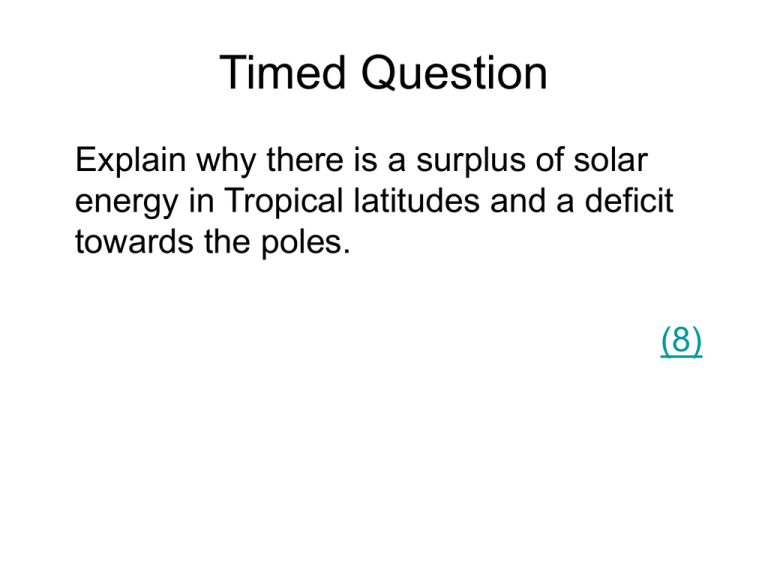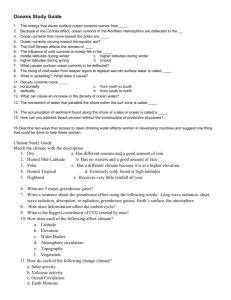Oceanic Circulation
advertisement

Timed Question Explain why there is a surplus of solar energy in Tropical latitudes and a deficit towards the poles. (8) Peer Assessment Explain why there is a surplus of solar energy in Tropical latitudes and a deficit towards the poles. Answers might include; • The sun strikes the Earth vertically at the Tropics • The sun’s rays pass through less atmosphere at the Tropics – less is lost through absorption or reflection • The heat is more concentrated, does not have to heat up as much surface area. • At the poles the solar radiation is used to heat up larger areas • The sun’s rays pass through more atmosphere – so more is lost • The tropics are covered in dense forest which absorb solar radiation – low albedo • The Poles are covered in snow and ice which reflect solar radiation – high albedo Oceanic Circulation Land surfaces heat up and cool down much quicker than the Oceans (low specific heat). This makes land surfaces warmer than oceans in summer, but colder in winter. This gives them a high annual temperature range. Oceans have a higher specific heat because they absorb heat to a greater depth. This means that they heat up and cool down more slowly than land. This means that they are colder than land in the summer, but warmer than the land in winter. Together with wind, ocean currents are the means by which heat energy is redistributed around the world. What Happens? Temperatures are higher at the Tropics than they are at the Poles. This causes the water to expand and move outwards towards the poles, where the water is contracting as it cools. The Coriolis Force causes the ocean currents to deflect as they move polewards. Winds may also drag the surface water along with them When the ocean currents meet shallow water near the continents, they are deflected in both directions. Eventually the ocean current must complete a circuit called gyre. Ocean Currents; Case Study of the North Atlantic 1. Warm water in the Gulf of Mexico expands and moves polewards, as the Gulf Stream 2. As it moves north it is deflected by the Coriolis Force to move north-easterly. 3. South westerly winds drag the water even further north-east 4. On reaching Europe, some of the current deflects southwards to become the cold Canary Current. 5. Some of the current is deflected north as the North Atalantic Drift 6. Once past Norwary, NAD meets norht-easterly winds and returns southwards as the East Greenland Current and the Labrador Current to rejoin the Gulf Stream. 7. Meanwhile, the Canary Current is dragged by north-easterly trades to the Equator – it cannot go further because it meets south-easterly trades, so it moves west along the equator as the North Equatorial Current until if rejoins the Gulf Stream. Labrador Current North Atlantic Drift Gulf Stream Gulf of Mexico Canary Current In the South Atlantic 1. Water moves the opposite way in the South Atlantic 2. Instead of a figure of 8 pattern, the water makes a single gyre 3. Water moves southwards from the Tropics as the Brazilian Current, but it is deflected to the left by the Coriolis Force across the the Atlantic and deflected by the African coast northwards as the Benguelan Current and completes an anticlockwise gyre as the South Equatorial Current, dragged by south-easterly trades. Effects; Warm Currents: Move Polewards Raise Coastal Temperatures Increase Coastal Rainfall because of greater evaporation from warm water Cold Currents: Move Equatorialwards Reduce Coastal Temperatures Reduce Rainfall, because of lower evaporation from cool sea. Task 2: New Higher Geography textbook page 6 Activity 5 question a – e Homework for Thursday 28th Feb Describe and account for the pattern of ocean currents in either the Atlantic Ocean or the Pacific Ocean. (10) Allow yourself 7 minutes for this





